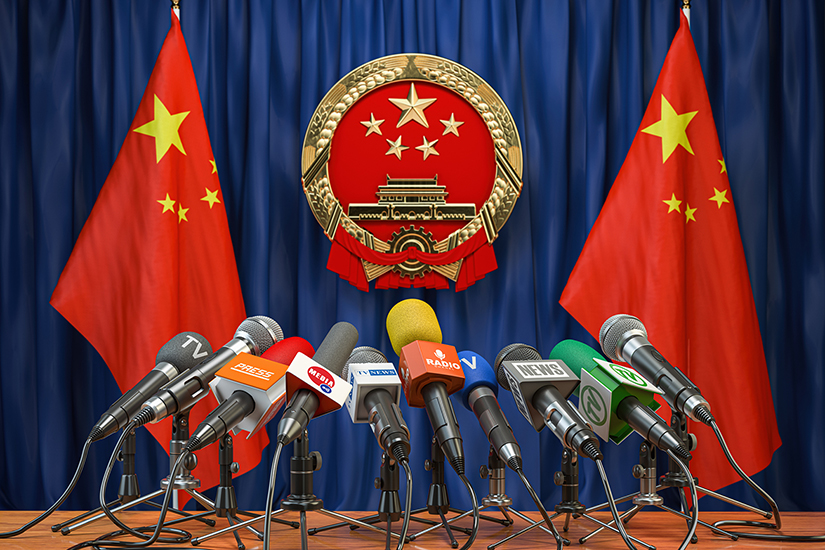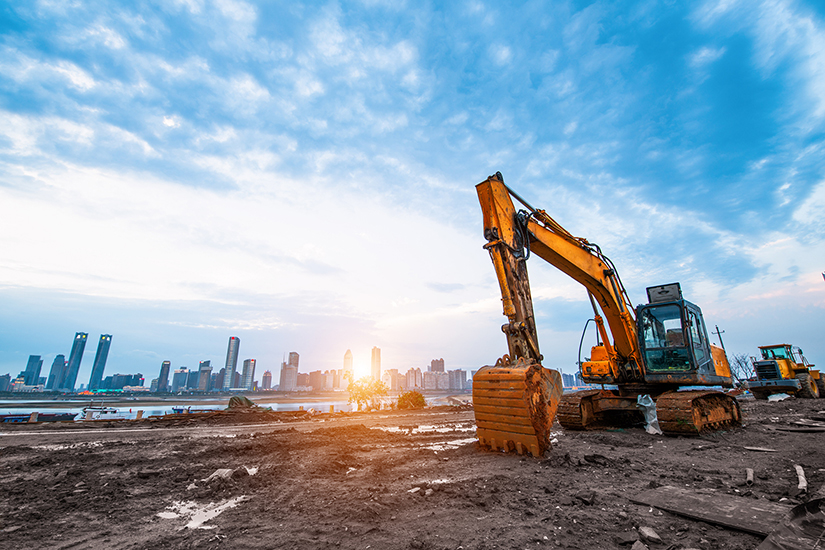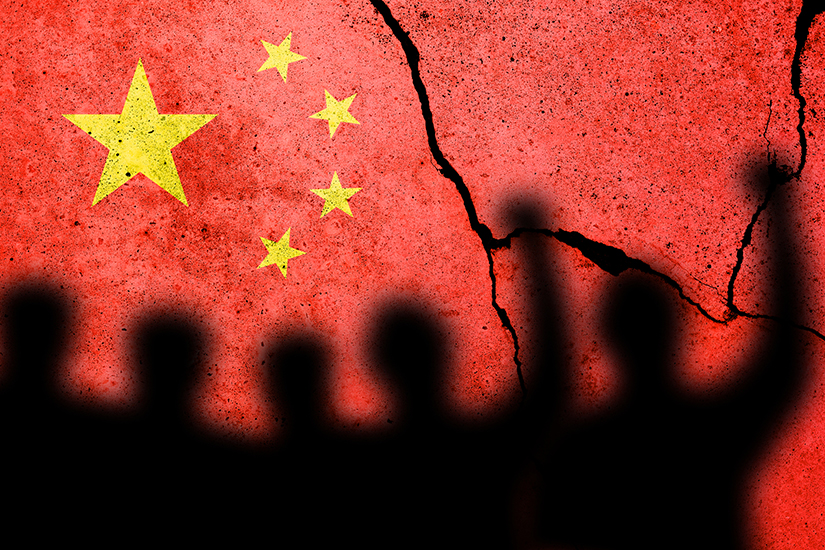In times of peace, there is but little sense of danger among the general population. Civil air defense is far from people’s minds. Today, however, we stand on the verge of an upheaval in the international situation. Unilateralism runs rampant, and the human race faces a once-in-a-century transformation. There is an imminent need to foster and rebuild a sense of danger and an awareness of civil air defense among the masses.
This is an extract from a public message by the Shanghai Municipal Civil Air Defense Office[1] appealing to the citizens of Shanghai, on August 3, 2022.[2] Late the previous night, Nancy Pelosi, then Speaker of the United States House of Representatives, had arrived in Taiwan. Her visit sparked a chorus of criticism from the Chinese domestic media on August 3, of which this article was one voice.
Are Shanghai and other major cities on the Continental China really in imminent danger of air raids and bombing? Why, at this time, is it necessary to foster a sense of danger among the masses?
Civil Air Defense: China’s Civil Protection
Civil air defense mobilizes and organizes the masses to implement defense measures aimed at preventing and minimizing the danger and damage of air raids.[3] Initiatives such as this are generally referred to in the international community as “civil defense.” In Japan, where the Civil Protection Law was established in 2004 for the purpose of protecting the lives and property of citizens in the event that Japan sustained an armed attack or similar disaster, it is referred to as “civil protection.” A variety of civil protection measures have been implemented by the national and local governments in Japan.[4] Civil air defense can therefore be characterized as China’s version of Japan’s “civil protection.”
Civil air defense began at around the time of the establishment of the People’s Republic of China, with the construction of air raid shelters to protect the Communist Party’s military forces and people from bombing and air raids by the Nationalist Party (Kuomintang) army and other enemies. Zhou Enlai, then Premier of China, formalized this effort on October 31, 1950, immediately after China entered the Korean War with the dispatch of the People's Volunteer Army to the Korean Peninsula.[5]
Subsequently, in the era of the 1960s Sino-Soviet split, China engaged in the nationwide, systematic construction of public emergency evacuation sites, as well as military and other facilities, air defense warning and communication systems, and public air defense training. After the Taiwan Strait Missile Crisis, these initiatives were codified in the 1997 Civil Air Defense Law. Specifically, these comprise the mobilization of the general public, companies and other organizations by local governments, under the direction of central government bodies including the State Council and the Central Military Commission, to undertake Military-Civil Fusion activities such as the stockpiling of food, medicines, petroleum and other vital supplies in preparation for war and the protection of industrial and mining bases, scientific research facilities, transport networks, communications facilities, bridges, dams, power stations and other key economic infrastructure.
China integrated preparations for mass evacuations and the stockpiling of food and other provisions into the construction of urban infrastructure and facilities such as residential and commercial areas, subways and other public facilities. Multi-use underground facilities incorporating air defense facilities, nicknamed dixiacheng (underground cities) or dixia changcheng (the underground Great Wall) progressively appeared in over 100 cities around the country.[6]
After China’s reform and opening-up and the improvement in US-China relations, however, these air defense facilities—the so-called underground cities—were progressively abandoned. Society’s former fear and sense of the imminent threat of an attack on the Chinese mainland from enemy forces such as the Nationalist army, the United Nations forces in Korea, and the Soviet army gradually receded into the background. Perhaps it was this diminished sense of danger that gave rise to the characterization of the air defense facilities as wudidong (bottomless pits) that served little use despite swallowing up large budgets.[7]
In around 2008, when I was stationed in China, many of the underground cities located in central Beijing and Shanghai had been unlawfully converted to residences and disreputable stores. Some had even been forgotten by time and fallen into ruin.

The Revitalization of Civil Air Defense
Civil air defense has recently begun to reappear in the Chinese domestic media, and articles concerning subterranean air defense facilities have become increasingly conspicuous.
This change in attitude to civil air defense can be traced back to the 18th National Congress of the Communist Party of China (CPC) in 2012, at which Xi Jinping was appointed General Secretary of the CPC Central Committee and Chairman of the Central Military Commission. The new attitude became entrenched after Xi’s address at the 7th National Conference on People’s Air Defense in 2016.[8]
Amid a changing situation at home and abroad, Xi Jinping identified civil air defense as a key strategic element of national security in China’s 13th Five-Year Plan. In this context, Premier Li Keqiang emphasized civil air defense efforts as a way to further develop Military-Civil Fusion, enhancing effective combat-readiness while also boosting social and economic interests.[9]
In recent years, the construction of civil air defense facilities is once again progressing vigorously across coastal cities such as Shanghai and Shenzhen, in tandem with the construction of residential, commercial, and other buildings and the development of underground infrastructure such as subways, tunnels, and multi-use pipelines.

For example, building renovations for a high school in one district in Shanghai include the construction, beneath new buildings, of an underground air raid shelter and facility for the storage of supplies and food in times of war. As this will be used by parents for dropping off and picking up students and as a car park for nearby residents in times of peace, the local authorities are more than happy to report on the additional budget allocations required.[10]
There have been reports of one city in Jiangsu Province where the government repaired a damaged underground air raid shelter that had been unlawfully modified, made the location of the shelter known to the relevant residents, and launched a public relations exercise to promote its proper use.[11]
Many cities have begun to focus on publicity and education as a “last mile” initiative to spread knowledge and familiarity of civil air defense among the general public.[12]
Meanwhile, however, public interest in civil air defense has been waning since the time of China’s reform and opening-up, with underground shelters lying forgotten and air raid drills reduced to simply sounding a siren. This lack of attention enabled official corruption to run rampant in related businesses: a fact that was exposed by the Xi Jinping administration’s anti-corruption campaign, and the arrest and punishment of the perpetrators made public. In this way, together with the construction of new facilities, China has worked to eliminate the negative image of underground shelters as “bottomless pits.”[13]
In this way, the Xi administration has been engaged in civil air defense since 2016, but the full-scale construction of facilities and other efforts only began around 2020. Reports of the completion of facilities and public education and training have grown progressively more common since around 2022.
Beijing, Shanghai, and other cities have shown indications of increasingly systematic efforts to reorganize and strengthen related local government departments, including the department formerly responsible for civil air defense (the Beijing Municipal Civil Air Defense Office) and its reorganization into a newly-formed department (the Beijing Municipal National Defense Mobilization Office).[14]
Notwithstanding the time lag between planning and implementation, this trend should be perceived in terms of the Xi administration’s efforts to encourage Chinese citizens to understand the changes in China's global environment, including factors such as the harsh response by Europe and the US to Russia’s invasion of Ukraine and US-China antagonism over Taiwan, as well as the Xi administration’s readiness to attempt to precipitate a change in the status quo through force.
In Place of a Conclusion
At the Shangri-La Dialogue held in early June, Chinese Defense Minister General Li Shangfu spoke strongly on the issue of Taiwan. “We will not rule out the use of force. If anyone dares to split Taiwan from China, the Chinese military will resolutely safeguard China's national sovereignty and territorial integrity without any hesitation, at all cost, and not fearing any opponent.”[15]

However, if China were actually to launch an armed attack, it would need to mobilize the people and force them to make sacrifices. The cost would be incalculable. In such an event, any administration that did not make sufficient efforts to protect the lives and property of the people from enemy counterattacks and attacks on the continental homeland would be swiftly overturned by the people. There is no doubt that the Xi Jinping administration gained a renewed awareness of this risk through its response to COVID-19.[16]
In an authoritarian, single-party autocracy, the alienation of the people and the loss of their support leads directly to the collapse of the regime. “In fact, no step has ever been taken that a majority of citizens would oppose or be dissatisfied with. (...) This illustrates just how much pressure the authorities receive from their citizens.[17] It is especially crucial for the Xi Jinping administration to make the Chinese people feel secure by showing them that even in the event of an enemy attack, the CPC will protect them.
Today, as we witness Russia’s invasion of Ukraine, perhaps the probability of China making an enemy of the international community by engaging in an armed offensive has actually declined. However, the words and actions of China’s top leaders and the activities of its armed forces including coast guard and militias seem to indicate that it would not be surprising if a chance incident somewhere led to a military confrontation and, in the worst-case scenario, escalated into a full-scale US-China armed conflict.
It is unlikely that China’s leadership, headed by Chairman Xi, is looking forward to an armed invasion of Taiwan or a full-scale military confrontation with the United States. The revitalization of civil air defense and the implementation of other measures to win the hearts and minds of the people by mitigating their concerns over the damage from any potential conflict should, however, be perceived as a barometer indicating the Chinese leader’s readiness to weather the worst possible scenario as the head of the nation and the status of China’s preparations for war, over and above the aggressive activities of Chinese military aircraft and warships and the spirited words of its senior officials.
For those of us who live in a liberal democratic society, actions such as the implementation of China’s anti-spy law, the national security law targeting Hong Kong, and its rule over the Uighur people in disregard for human rights are unreasonable to the point of absurdity. However, they take on a different aspect when perceived as a barometer of the CPC's preparations and resolve to weather civil unrest. I would like to consider this aspect in a separate paper.
(2023/07/13)
Notes
- 1 Since 2023, the Shanghai Municipal Civil Air Defense Office has taken on the name “Shanghai Municipal National Defense Mobilization Office” in its activities, in the same way as the Beijing municipal government in footnote 14.The fact that this office has established several online noticeboards related to the mobilization of the general public and private sector companies also indicates that it is managed as a single office.
- 2 Shanghai Civil Defense “Civil Air Defense: Always At the Ready!” Shanghai Observer, August 3, 2022.
- 3 Civil Air Defense Law of the People's Republic of China, Article 2, Central State Civil Air Defense Network
- 4 Cabinet Secretariat Civil Protection Portal Site
- 5 Yamamoto, Katsuya. “Column (167): A Defense/Naval Attaché’s Observations of China (Number 18) – the Korean War, China, the United Nations, Japan –” JMSDF Command and Staff College website, June 16, 2015
- 6 Zhao, Jie. “Underground Cities, the Underground Great Wall.” Zhongguo Guofangbao (China National Defense News), June 28, 2019
- 7 Ibid
- 8 Ibid
- 9 “Xi Jinping: Firmly Maintaining Civil Air Defense for the People and Pioneering a New Era in Civil Air Defense Efforts.” Xinhua Network, May 13, 2016.
- 10 Xie, Xiaobo and Tang, Shuo. “Progress on the Civil Air Defense Construction Project in Fengxian District, Shanghai – Great Enhancements to the ‘Underground Great Wall.’” Zhongguo Guofangbao (China National Defense News), April 14, 2023
- 11 Jiang, Huisheng. “A Civil Defense Project in Jiangsu Province Carries Signs to the ‘Underground Great Wall’ Recognizable to All.” Zhongguo Guofangbao (China National Defense News), December 23, 2022
- 12 Li, Gen. “Dezhou’s Civil Defense System: Solidly Building the ‘Underground Great Wall.’” Dezhou Ribao (Dezhou Daily), December 21, 2022
- 13 Liu, Yangtao and Wang, Hao. “Building the ‘Underground Great Wall’ of Civil Air Defense Strongly through Anti-Corruption.” Xinhua Network, April 21, 2021
- 14 “Establishment of the Beijing Municipal National Defense Mobilization Office.” Chinanews.com, December 28, 2022
- 15 “Asia Security Summit the Shangri-La Dialogue, Fifth Plenary Session, Sunday 4 June 2023, General Li Shangfu, State Councilor; Minister of National Defense, China,” International Institute for Strategic Studies, June 4, 2023.
- 16 16. For example, in November 2022, the public anger at authorities sparked by a fire in a high rise apartment building in Urumqi, which was under a prolonged lockdown at the time, spread swiftly across the whole of China, forcing the Xi Jinping administration to drastically alter its COVID-19 countermeasures.
- 17 17. Miyamoto, Yuji. China in 2035 – Will the Xi Jinping Way Survive? Shinchosha, April 2023, pp. 24-25

